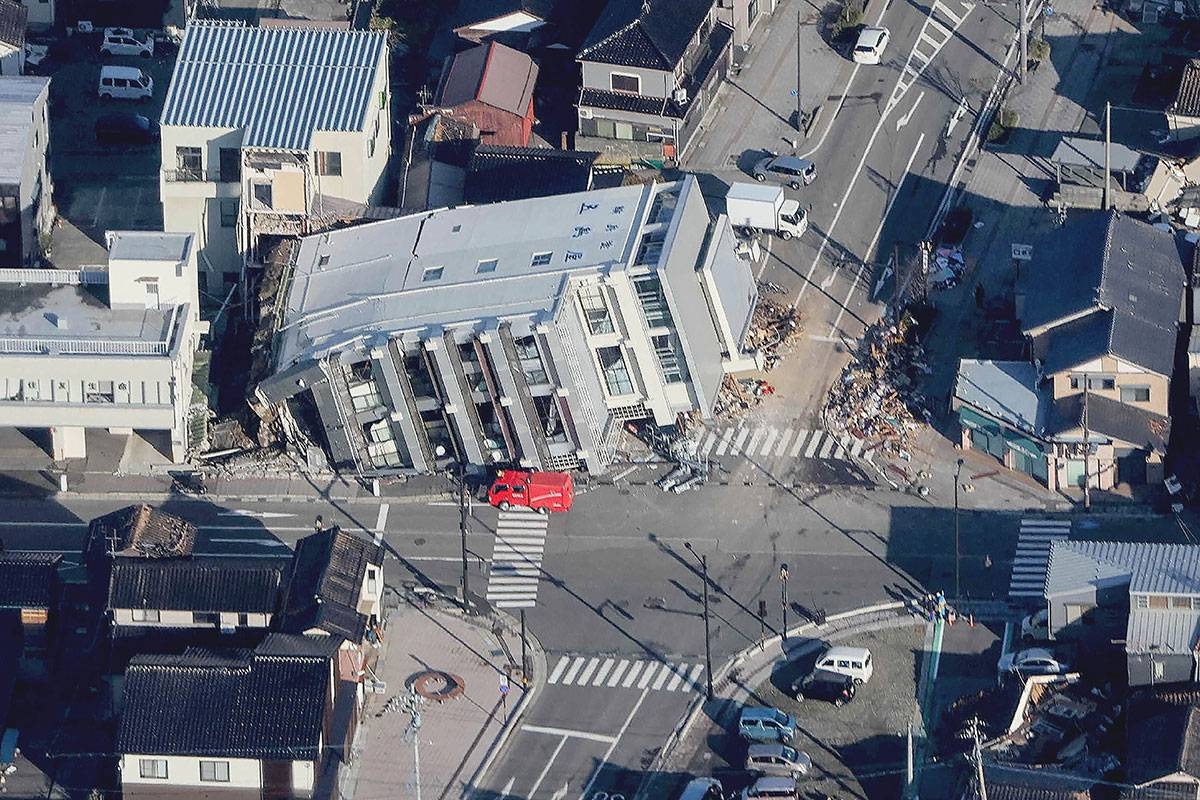WAJIMA, Japan: Japanese rescuers battled the clock and powerful aftershocks Tuesday to find survivors of a New Year’s Day earthquake that killed at least 48 people and caused widespread destruction.
The 7.5 magnitude quake that rattled Ishikawa prefecture on the main island of Honshu triggered tsunami waves more than a meter high, toppled houses, caused a major fire, and tore apart roads.
On the Noto Peninsula, the destruction included buildings damaged by fire, houses flattened, fishing boats sunk or washed ashore, and highways hit by landslides.
“I’m amazed the house is this broken, and everyone in my family managed to come out of it unscathed,” said Akiko, standing outside her parent’s tilting home in the badly hit city of Wajima.
The way 2024 started “will be etched into my memory forever,” she told Agence France-Presse (AFP) after what she called the “long and violent” earthquake on Monday.
“It was such a powerful jolt,” Tsugumasa Mihara, 73, told AFP as he queued with hundreds of others for water in the nearby shell-shocked town of Shika.
Local authorities put the death toll at 48, but the number was expected to rise as rescuers combed through the rubble.
“Very extensive damage has been confirmed, including numerous casualties, building collapses, and fires,” Prime Minister Fumio Kishida said after a disaster response meeting.
“We have to race against time to search for and rescue victims of the disaster.” Aerial news footage showed the terrifying scale of a fire that ripped through the old market area of Wajima, where a seven-story commercial building also collapsed. Quake damage impaired rescue efforts to put out the blaze.
Almost 33,000 households were without power in the region, which saw temperatures touch freezing overnight, the local energy provider said. Many cities were without running water.
The US Geological Survey said the quake had a magnitude of 7.5. Japan’s meteorological agency measured it at 7.6 and said it was one of more than 150 to shake the region through Tuesday morning.
Several strong jolts were felt early Tuesday, including one measuring 5.6 that prompted national broadcaster NHK to switch to a special program.
“Please take deep breaths,” the presenter said, reminding viewers to check for fires in their kitchens.
Tsunami warning lifted
On Monday, waves at least 1.2 meters (4 feet) high hit Wajima, and a series of smaller tsunamis were reported elsewhere.
Warnings of much larger waves proved unfounded, and on Tuesday, Japan lifted all tsunami warnings.
Images on social media showed cars, houses, and bridges in Ishikawa wobbling violently as terrified people cowered in shops and train stations. Houses collapsed, and huge cracks appeared in roads while others were hit by landslides. Forecasters warned that rains could further loosen soil on hillsides.
A team of firefighters crawled under a collapsed commercial building in Wajima looking for survivors, television footage showed.
“Hang in there! Hang in there,” they shouted as they battled through piles of wooden beams with an electric saw.
The fire in Wajima engulfed as many as 200 structures, reports said, with people evacuated in the dark, some with blankets and others carrying babies.
NHK reported that 25 houses had collapsed in the city, including 14 that may have had people trapped inside.
A duty officer at the Wajima Fire Department said authorities were overwhelmed Tuesday by rescue calls and reports of damage.
Ishikawa Gov. Hiroshi Hase wrote on social media that roads had been cut in widespread areas by landslides or cracking, while in the port of Suzu, “multiple” vessels had capsized.
A total of 62,000 people had been ordered to evacuate, according to the fire and disaster management agency.
About 1,000 were staying at evacuation centers, where they received assistance and support from local authorities and volunteers.
The earthquake in Wajima has left a trail of devastation and loss. As rescuers continue their search for survivors, the clock is ticking, and the powerful aftershocks only add to the urgency of the situation.
Local authorities and the Prime Minister have expressed their determination to rescue as many victims as possible, despite the extensive damage and challenging conditions.
The resilience and strength of the affected communities are evident as survivors recount their experiences and express gratitude for their safety amidst the destruction.
With power outages and limited access to basic necessities like water, the affected regions are facing additional hardships in the aftermath of the earthquake.
However, the lifting of the tsunami warnings brings some relief, as the immediate threat of further waves subsides.
As the international community watches the events unfold in Wajima, it is a reminder of the unpredictable and devastating nature of earthquakes.
Our thoughts are with the affected individuals and their families, and we hope for a swift and successful rescue operation to save as many lives as possible.
Source: The Manila Times








